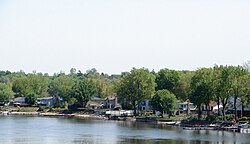L'Île-Perrot, Quebec
L'Île-Perrot | |
|---|---|
City | |
 | |
 Seal | |
 Location within Vaudreuil-Soulanges RCM. | |
 L'Île-Perrot Location in southern Quebec. | |
| Coordinates: 45°23′N 73°57′W / 45.383°N 73.950°WCoordinates: 45°23′N 73°57′W / 45.383°N 73.950°W[1] | |
| Country | |
| Province | |
| Region | Montérégie |
| RCM | Vaudreuil-Soulanges |
| Constituted | July 1, 1855 |
| Government | |
| • Mayor | Pierre Séguin |
| • Federal riding | Vaudreuil-Soulanges |
| • Prov. riding | Vaudreuil |
| Area | |
| • Total | 5.50 km2 (2.12 sq mi) |
| • Land | 5.56 km2 (2.15 sq mi) |
| There is an apparent contradiction between two authoritative sources | |
| Population (2011)[4] | |
| • Total | 10,503 |
| • Density | 1,889.8/km2 (4,895/sq mi) |
| • Pop 2006-2011 | |
| • Dwellings | 4,701 |
| Time zone | UTC−5 (EST) |
| • Summer (DST) | UTC−4 (EDT) |
| Postal code(s) | J7V |
| Area code(s) | 514 and 438 |
| Highways | |
| Website | www |
The Town of Île-Perrot (French/Official Name: Ville de l'Île-Perrot) is a town and municipality on Île Perrot in southwestern Quebec, Canada. The population as of the Canada 2011 Census was 10,503. The town is at the western end of Lake Saint-Louis, and borders the local island communities of Terrasse-Vaudreuil, Pincourt and Notre-Dame-de-l'Île-Perrot. It also includes Dowker Island and the small Claude and Bellevue Islands (Île Claude and Île Bellevue).
Demographics[]
Population[]
| hideCanada census – L'Île-Perrot, Quebec community profile | |||
|---|---|---|---|
| 2011 | 2006 | ||
| Population: | 10,503 (+5.8% from 2006) | 9,927 (+5.9% from 2001) | |
| Land area: | 5.56 km2 (2.15 sq mi) | 5.56 km2 (2.15 sq mi) | |
| Population density: | 1,889.8/km2 (4,895/sq mi) | 1,786.0/km2 (4,626/sq mi) | |
| Median age: | 40.6 (M: 39.5, F: 41.7) | 38.6 (M: 38.2, F: 39.0) | |
| Total private dwellings: | 4,701 | 4,371 | |
| Median household income: | $55,233 | $66,035 | |
| References: 2011[4] 2006[5] earlier[6] | |||
|
|
|
Language[]
| Canada Census Mother Tongue - L'Île-Perrot, Quebec[7] | ||||||||||||||||||
|---|---|---|---|---|---|---|---|---|---|---|---|---|---|---|---|---|---|---|
| Census | Total | French
|
English
|
French & English
|
Other
| |||||||||||||
| Year | Responses | Count | Trend | Pop % | Count | Trend | Pop % | Count | Trend | Pop % | Count | Trend | Pop % | |||||
2011
|
10,315
|
6,840 | 66.31% | 2,140 | 20.75% | 185 | 1.79% | 1,150 | 11.15% | |||||||||
2006
|
9,825
|
7,365 | 74.96% | 1,630 | 16.59% | 100 | 1.02% | 730 | 7.43% | |||||||||
2001
|
9,265
|
7,305 | 78.85% | 1,430 | 15.43% | 110 | 1.19% | 420 | 4.53% | |||||||||
1996
|
9,025
|
7,295 | n/a | 80.83% | 1,320 | n/a | 14.63% | 95 | n/a | 1.05% | 315 | n/a | 3.49% | |||||
Infrastructure[]
Transportation[]
Autoroute 20 runs through the town, with three at-grade intersections serving as exits. The east side of L'Île-Perrot is bordered by a branch of the Ottawa River with a crossing via Autoroute 20 over the Galipeault Bridge (Pont Galipeault) to Sainte-Anne-de-Bellevue on Montreal Island.
There is a shuttle bus service operated by CIT La Presqu'Île connecting to the Île-Perrot station on the Vaudreuil-Hudson commuter rail line.
Schools[]
There are 3 francophone elementary schools (Virginie Roy, François-Perrot and La Perdriolle) and an adult education centre in L'Île-Perrot, all run by the Commission Scolaire des Trois-Lacs.[8]
Lester B. Pearson School Board operates Anglophone schools. The community is zoned to Dorset Elementary School in Baie-d'Urfé.[9]
See also[]
- List of cities in Quebec
References[]
- ^ Reference number 177380 of the Commission de toponymie du Québec (in French)
- ^ Jump up to: a b "Ministère des Affaires municipales, des Régions et de l'Occupation du territoire: L'Île-Perrot". Archived from the original on 2013-12-15. Retrieved 2012-03-11.
- ^ "Parliament of Canada Federal Riding History: VAUDREUIL-SOULANGES (Quebec)". Archived from the original on 2009-06-18. Retrieved 2009-03-23.
- ^ Jump up to: a b c "2011 Community Profiles". 2011 Canadian Census. Statistics Canada. July 5, 2013. Retrieved 2014-02-01.
- ^ "2006 Community Profiles". 2006 Canadian Census. Statistics Canada. March 30, 2011. Retrieved 2014-02-01.
- ^ "2001 Community Profiles". 2001 Canadian Census. Statistics Canada. February 17, 2012.
- ^ Jump up to: a b Statistics Canada: 1996, 2001, 2006, 2011, 2016 census
- ^ "Les écoles et les centres". Commission Scolaire des Trois-Lacs. Retrieved 18 January 2013.
- ^ "School Board Map." Lester B. Pearson School Board. Retrieved on September 28, 2017.
External links[]
- Cities and towns in Quebec
- Greater Montreal
- Incorporated places in Vaudreuil-Soulanges Regional County Municipality
